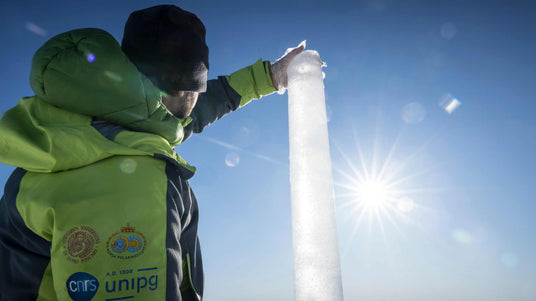A new international mission has successfully concluded on the Corbassière glacier , 4,100 meters below the summit of the Grand Combin. This mission is part of the Ice Memory project, of which AKU has been a technical sponsor since its founding in 2016. This scientific and human undertaking confirms the urgency of collecting and preserving ice cores from the planet's most iconic glaciers, before global warming erases their memory forever.
Corbassière is no ordinary place: an initial expedition to study the site and understand how to extract its precious ice was undertaken in 2018. Two 15-meter surface cores were collected, and a survey was conducted to identify the best site for deep drilling, reaching the bedrock at the base of the glacier. A first drilling attempt followed in 2020, but it was unsuccessful due to the unexpected presence of water in the deep layers, a dramatic sign of the rapidity with which climate change is transforming the structure of Alpine glaciers. "The analysis of those samples showed that the upper layers had already lost part of the chemical information stored in the ice due to the percolation of meltwater," explains Jacopo Gabrielli, a chemist at the Institute of Polar Sciences of the CNR in Venice who was involved in the mission. "For us, it was a painful confirmation: we are losing unique natural archives much faster than we imagined ."
Five years later, in the spring of 2025, the team of researchers from the CNR-Institute of Polar Sciences and Ca' Foscari University of Venice, with the technical support of international partners, returned to the glacier with instruments suited to the situation. After a complex campaign of georadar surveys to identify the optimal site, electromechanical and electrothermal corers recovered two 99.5-meter-deep cores down to the bedrock . One of these will be analyzed immediately, while the other will be preserved in Antarctica for future generations, contributing to the Ice Memory "global ice library." Atop the Grand Combin with Jacopo Gabrieli, among those most excited about reaching the bedrock are Agnese Petteni and Giulia Vitale , PhD students from Ca' Foscari. Their contribution is not limited to the present but is projected into the future: new research methodologies and new instruments could pave the way for new discoveries still hidden in the extracted ice.
The conditions on the ground were extreme: wind, temperatures below -18°C, logistical challenges, and the need to work for days at high altitude, in isolation. But the effort paid off. “ Glaciers preserve the memory of past climate and environment , but they are retreating rapidly due to global warming,” recalls Carlo Barbante , scientific director of Ice Memory and one of the world's most respected paleoclimatologists. “This is a unique opportunity to save what remains of that memory , before it is lost forever.”

Eisgedächtnis
Ice Memory is an international program born with the aim of providing, for decades and centuries to come, archives and data on the history of climate and the environment, fundamental both for science and to inspire policies for the sustainability and well-being of humanity .
For AKU, participating in this challenge means reaffirming a principle that has always guided us: responsibility. The responsibility of producing quality footwear while minimizing environmental impact , but also of supporting projects that help us understand the history of our planet in order to improve our relationship with the environment. Because there are no consumers, but conscious users , called to choose with care and respect.
The Grand Combin 2025 mission reminds us that time is running out, but also that research, collaboration, and shared responsibility can open glimpses of the future. What is saved in the ice cylinders today will be a precious legacy for generations to come: a fragile, yet essential, archive for understanding and addressing changes in our climate .












